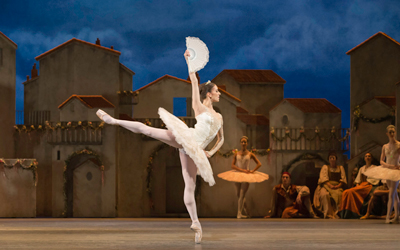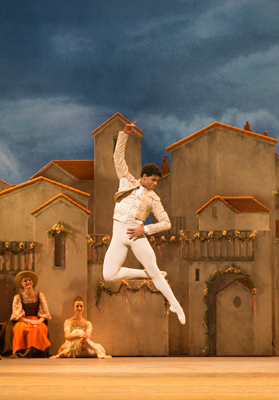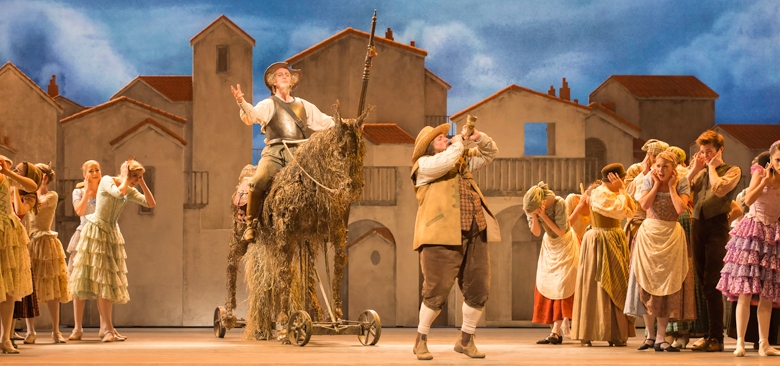Don Quixote is, for many British people, a quintessential staple of Spanish culture, and it’s no surprise that this ballet, choreographed by Cuban Carlos Acosta – who also dances the role of Basilio alongside Spanish ballerina Marianela Nuñez– has been seen as a showcase for all of that fiery Latino spirit that we Brits are convinced is an essential characteristic of our Mediterranean neighbours. And yet, somehow, there’s something about the whole production that doesn’t quite ring true.
Saunders as Don Quijote © ROH 2013 / Johan Persson
Don Quixote is, for many British people, a quintessential staple of Spanish culture, and it’s no surprise that this ballet, choreographed by Cuban Carlos Acosta – who also dances the role of Basilio alongside Spanish ballerina Marianela Núñez– has been seen as a showcase for all of that fiery Latino spirit that we Brits are convinced is an essential characteristic of our Mediterranean neighbours. And yet, somehow, there’s something about the whole production that doesn’t quite ring true.
Of course, it’s arguably a bit unfair to accuse Acosta of inauthenticity in a production of a ballet originally created in 19th century Moscow, with its flamenco-inspired music (apparently typically Spanish), composed by Austrian Ludwig Minkus. And if it’s familiar scenes from the book that you’re after, well, there’s the windmills, and if you concentrate really hard there’s Sancho Panza being thrown around in a blanket, but that’s about it.
a Don Quixote in which the old caballero himself is side-lined; mocked by the young lovers who have usurped his central role. This is not really surprising, since ballet is an art for young and beautiful people, and it doesn’t necessarily mean that the production has lost the meaning of the original text.
But the claim that Acosta makes on the Royal Opera House’s introduction to the production is that he intended his choreography to “shake up” a tired old classical production by introducing some real “Spanish flair”. What exactly does that mean? Well, for starters there are the costumes – all matadors and flamenco dresses – and before long a whole ensemble appears, leaning over balconies and dancing on inn tables, stamping and clapping and clicking and shouting. So far, so… Spanish?

Núñez as Kitri. Photos © ROH 2013 / Johan Persson
Because to me, this isn’t so much a celebration of Spanish culture in all of its wonderful richness and complexity, so much as a strange medley of stereotypes. It’s all very well having choreography inspired by flamenco or bull fighting, but what does that have to do with Don Quixote and Cervantes? What does it really have to do with Spain? Sticking a couple of live guitarists on stage supposedly adds authenticity, but are we really meant to swallow comments mocking previous productions where the dancers leapt around waving empty instruments, without recalling the scene in the first act where Acosta does just that? He even exchanges his guitar for his partner’s fan, demonstrating that it is exactly the same kind of empty prop. And whilst the guitarists in question are undoubtedly talented musicians, somehow their juxtaposition with the full orchestra and classical score that dominates the rest of the ballet feels awkward, even forced.

Acosta as Basilio. Photos © ROH 2013 / Johan Persson
And if we’re going to talk about stereotypes, Acosta seems determined to make sure that one cliché in particular about Spanish life and relationships sticks. In speaking about his overall vision of the ballet, he describes how he wants his male dancers to look: very strong and very masculine, or, in his words, “very Spanish”. And so we have matadors stomping and leaping around and a rather acrobatic fight between Basilio and a group of gypsies. But as is always the case with such demonstrations of Spanish machismo, there is a price that must be paid, and paid by the female counterparts to these hyper-masculine men. There is nothing unusual about a ballet in which women are constantly being picked up and thrown or carried around, but in this production the female characters are even more blatantly, and more gratingly, dependent than usual. The plot, of course, does not help, since it revolves around a woman attempting to escape a forced marriage with a ridiculous but rather rich suitor who intends to pay off her father. Her plan? Run off with her lover instead, and let him do all of the fighting for her. So much for female empowerment.
So there we have it: a Don Quixote in which the old caballero himself is side-lined; mocked by the young lovers who have usurped his central role. This is not really surprising, since ballet is an art for young and beautiful people, and it doesn’t necessarily mean that the production has lost the meaning of the original text. The contrast between the chaos, noise and bright colours of the crowd scenes, set in the real world, and the dream sequences of all-female ballerinas pirouetting in white tutus, is the nearest that a visual art can get to tackling the questions about reality, fiction and madness that the canonical novel poses. But I cannot help but feel that the scenes presented as reality are just as idealised as the dreams. Acosta is giving the British what they want, perhaps, but certainly playing to our stereotypes about our Iberian neighbours. In the choice between depicting a story and evoking Spanish flavour, whatever that might be, this production has definitely chosen the latter. So by all means go to see it, admire the flamenco arm waving, the macho posturing of the toreadors and the guitarists’ strumming, but don’t for a second imagine that it has anything to do with Miguel de Cervantes, or with the reality of Spain, in the 16th century or now.

